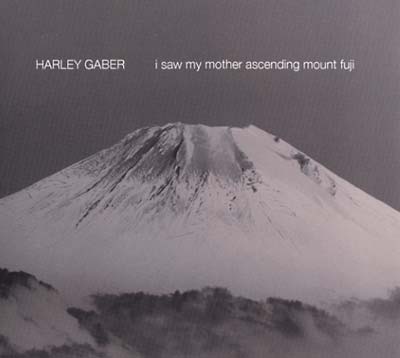GABER, HARLEY - I Saw My Mother Ascending Mount Fuji
""Just over one hour and five minutes, Harley Gaber's I Saw My Mother Ascending Mount Fuji (2009, for tape and processed violin and alto flute) offers proof of music's power to transport (the listener) in ways generally associated with film and literature. Fuji's Kaidan-like atmosphere -- the Japanese world of ghosts and spirits -- unfolds slowly in its process of uncovering and revealing a deeper and different spirit world in what might be termed a spiritual journey: The ascension and transformation of the human spirit into pure energy expressed in the form of both musical and non-musical sounds. Throughout the 1960s and 1970s, Gaber found his own unique compositional language that combined the intensity and extra-musical framing of certain post-war, European Modernism with sparser, more obviously spiritual evocations of Eastern aesthetics, as made manifest in such diverse expressions as Haiku poetry, Sumi-e painting, and even martial arts forms. In 1978, he moved from New York City to La Jolla, CA and stopped making music. Following a two-year hiatus from the arts, he commenced on what was to become a twenty year period of creating an immense body of work in the plastic arts and photography. Much of the work done during that period was informed by his musical instincts and focused, as did much of his later music, on the unity and interrelatedness of things. His predilection for collage work in general reflects and confirms that focus. The years of making art culminated with his largest artistic and personal undertaking in the construction of Die Plage, a photo-collage work of some 5,500 (20 x16 in.) canvases detailing German history in the first half of the 20th Century. With the completion of Die Plage in the early part of 2002, Gaber turned to writing about the project and to filmmaking, first using images from Die Plage for his films and eventually moving on to other subjects. His return to music began with the creation of soundtracks for all his films. Initially, the soundtracks were (again) in a collaged form using, for the most part, music of others, but also incorporating his own music from old recordings and taped performances. His real return to music composition came in 2008 with his original soundtrack for Mein Kamps: Akt V (filmed in Berlin and named after the Berlin bakery chain Kamps). That original soundtrack (existing apart from the film as a strictly musical composition is titled 'Berliner Strassen Gesang') demonstrates a richer, more complex approach to crafting and shaping sound made possible by the use of the computer in composing the work along with the twenty years of rethinking his artistic outlook in general, and his musical thinking in particular. And now, with I Saw My Mother Ascending Mount Fuji, Gaber has returned to music composition. This new work is at once a processing of untimely deaths in his family and a reconsideration of earlier compositions -- Michi for solo violin (1972) and Chimyaku for solo alto flute -- which, in their processed and altered form and in conjunction with an entirely new tape part, project a new level of insight into the essential spiritual nature of sound and its physicality; '...both transcendentally abstract and distinctly human,' as the composer puts it. The ascension of Mount Fuji is a meditative journey, a spiritual odyssey perhaps, as real as it is imagined or metaphoric. The composer, however, leaves those distinctions for each listener to decide for his or herself."" - Innova.
-
Sale
- Regular price $14.00


